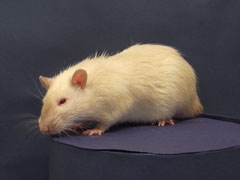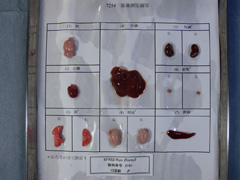| NBRP Rat No: |
Strain name: KFRS2/Kyo(hetero) |
Commmon Name: SRR02 |
Rat Genome Database |
| Principal Investigator: |
Takashi Kuramoto Graduate School of Medicine, Kyoto University Yoshidakonoe-cho, Sakyo-ku 606-8501 Kyoto Japan |
| Tel: 075-753-4494 Fax: 075-753-4409 |
Email: kuramot@anim.med.kyoto-u.ac.jp |
| Preservation Status: |
Embryo Sperm Living Animals |
 |
 |
| Coat Color |
siamese (sia) |
| Inbred Generations |
F19 (Jun 2010) |
| Usage Restrictions |
The recipient of BIOLOGICAL RESOURCE shall obtain a prior written consent on use of it from the DEPOSITOR.
For a commercial use of this resource, a new contract must be concluded between the depositor and the recipient. |
| Genetic Status |
|
| Comercial Availability |
|
|
| Research Category |
|
| Gene Affected |
Tyr: tyrosinase |
| Origin |
One male rat "SRR-Do Your Best" was introduced from American fancy rat colony (Spoiled Ratten Rattery: SRR, in Kansas City, Missouri) to Kyoto University on July 13, 2005. Inbreeding started from F1 progeny of male "SRR-Do Your Best" and a female PVG/Seac. (Sep 25, 2009) |
| Strain characteristics |
This strain has siamese mutation (sia) which causes pigmentation on the edge of the nose, hip and ear, as in the Siamese cat or for the satin mutation (sat) which causes rough fur. sia and sat were mapped to rat chromosome 1 and 3, respectively. Candidate gene analysis revealed that a missense mutation in exon 1 of the tyrosinase gene, S79P, was responsible for sia (Kuramoto, 2010). (May 24, 2010) |
| Breeding Conditions |
Maintained by crossing of homozygous and satin heterozygous. Poor breeding performance. Young females and old males are suitable for breeding. Id est, we start smear test at 7 weeks of age and cross females with their father (parent-offspring mating). (Sep 25, 2009) |
| Genotyping |
|
| References |
Kuramoto T, Yokoe M, Yagasaki K, Kawaguchi T, Kumafuji K, Serikawa T.
Genetic analyses of fancy rat-derived mutations.
Exp Anim. 2010;59(2):147-55. |
| Additional strain information |
|
|